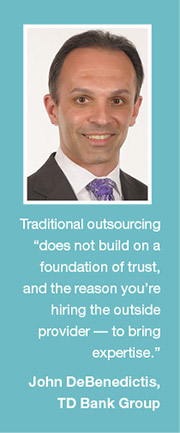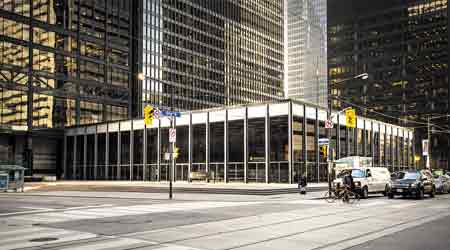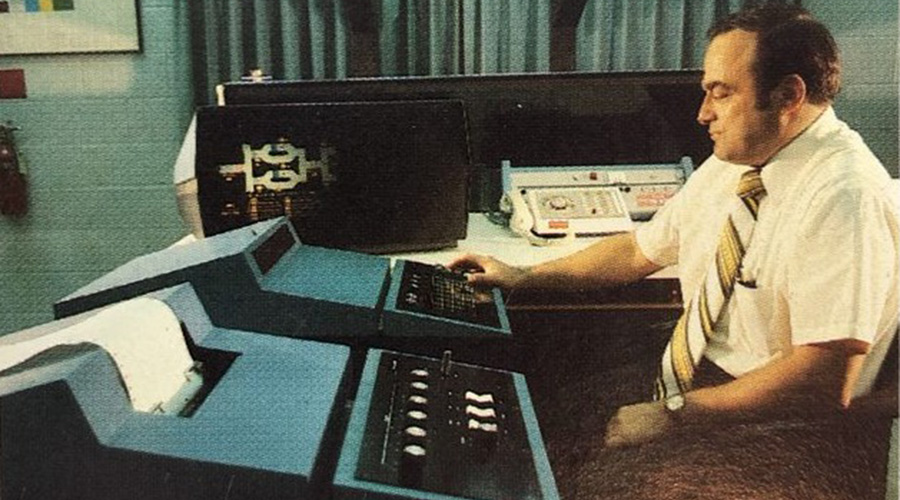TD Bank: Redefining Outsourcing Into True Partnership
Part 2 of a 6-part article profiling the 2016 FMXcellence honorees.
In 2014, TD Bank Group’s (TD) enterprise real estate team wanted to develop a more effective facility management outsourcing model. “We had a traditional outsourcing model of subject matter experts managing subject matter experts,” says John DeBenedictis, Canadian facilities director, enterprise real estate. That approach “does not build on a foundation of trust and the reason you’re hiring an outside provider — to bring expertise.”
To remedy this, TD worked with its outsourcing providers, Brookfield Global Integrated Solutions and C.B. Richard Ellis, to implement a Vested outsourcing model, a collaboration-based business model in which both parties are committed to the other’s success. (For more on the Vested approach, click here.)
First, the firms developed a shared vision: “We are aligned to deliver innovative and sustainable real estate solutions that create unparalleled value for our stakeholders.” They identified four outcomes against which the agreement would be measured: driving economic value to the organization through fair and transparent financials, providing holistic world-class real estate services, being an environmental leader, and being an innovative organization.
With this as a foundation, BGIS/CBRE gained autonomy to deliver services that meet the end goals, following five concepts. The first is focusing on outcome rather than transactions. For instance, rather than measuring cleaning tasks as the industry typically does, TD is working with the provider to develop site appearance goals and metrics, and allowing the provider to bring forward ideas to align to that desired outcome.
 Next, the firm’s focus shifted to “what,” rather than “how.” The provider could decide how to perform a job — whether on its own, using a contractor, or by some other method, so long as the desired outcomes were met.
Next, the firm’s focus shifted to “what,” rather than “how.” The provider could decide how to perform a job — whether on its own, using a contractor, or by some other method, so long as the desired outcomes were met.
The firms also adopted a “peer-to-peer service delivery approach.” When possible, employees are encouraged to resolve issues by using their judgment and working with their peers, both within their own firm and within the outsourcing firm. They escalate issues only when these steps fail to resolve them.
In addition, TD and its outsourcing providers narrowed their focus to a set of clearly defined and measurable outcomes. In the past, the parties monitored several dozen key performance indicators (KPIs). “They were getting into tactical measurements that didn’t benefit the end customer,” DeBenedictis says. Now, the focus is on eleven key KPIs that align to the goals.
Finally, the firms shifted to a pricing model that is transparent to both organizations, and focuses on the total cost of ownership to deliver a service, including account support areas like human resources, IT and legal. It also provides a shared incentive program if the outsource provider can deliver services at a lower total cost.
If the outsource provider meets the desired outcomes at the end of each year, its contract is automatically extended by another year. “The provider always has time to invest in new technology or resources, which provides a better foundation for innovation,” DeBenedictis says.
The Vested outsourcing arrangement encourages the providers’ employees to take ownership of their roles. For instance, door operators tend to require frequent repairs. The provider offered to have its technicians trained to repair these devices when on-site for HVAC or other preventive work.
Top photo caption and credit: Changing how outsourcing was structured allowed TD Bank to lower costs, increase response rates, focus more on the end customer, and increase provider profitability. Credit: Martin Galloway Photography
Related Topics:









 Next, the firm’s focus shifted to “what,” rather than “how.” The provider could decide how to perform a job — whether on its own, using a contractor, or by some other method, so long as the desired outcomes were met.
Next, the firm’s focus shifted to “what,” rather than “how.” The provider could decide how to perform a job — whether on its own, using a contractor, or by some other method, so long as the desired outcomes were met.







